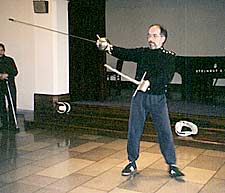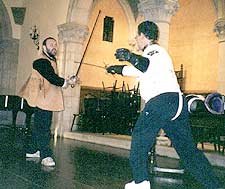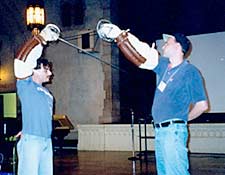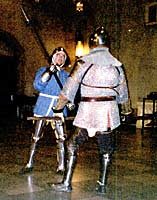Western Martial Arts Workshop 2001
Report by Ken Mondschein

Simply put, a Western martial art is one of the native fighting systems developed in Europe and her colonies. It is an umbrella term that includes unarmed arts such as French savate, Breton wrestling, and English boxing, as well as arts using weapons, such as knives, sticks, and swords. Added to these fighting arts that come down to us in a direct fashion are those which scholars and practitioners have spent years in reconstructing from available evidence, such as the armored fighting skills of the medieval knight or the rapier fencing of the Renaissance.
The work that has been done in studying and resurrecting these "lost" arts is quite astounding. Luckily, we do have some direct transmission, as in the manner of the Japanese koryu, to work from, and the language, pedagogical forms, and intent of the Western manuals are not as dissimilar to our way of thinking as those of some Asian arts are. It was the intention of the authors of these manuals to set out their art for future generations in a plain, explicit way. The techniques, and more importantly, the devastating principles behind their use, can thus be recovered and implemented with a fair degree of accuracy. Such arts are not only cultural artifacts and academic curiosities filling dusty volumes of scholarly rumination: they are extremely relevant to today, and frighteningly effective in their application.
The work that has been done in studying and resurrecting these "lost" arts is quite astounding. Luckily, we do have some direct transmission, as in the manner of the Japanese koryu, to work from, and the language, pedagogical forms, and intent of the Western manuals are not as dissimilar to our way of thinking as those of some Asian arts are. It was the intention of the authors of these manuals to set out their art for future generations in a plain, explicit way. The techniques, and more importantly, the devastating principles behind their use, can thus be recovered and implemented with a fair degree of accuracy. Such arts are not only cultural artifacts and academic curiosities filling dusty volumes of scholarly rumination: they are extremely relevant to today, and frighteningly effective in their application.
 |
Maestro Ramon Martinez of the Martinez Academy of Arms lectures on La Verdadera Destreza, the Spanish school of rapier fence. |
The annual Western Martial Arts Workshop (or WMAW for short) is thus more than just a martial arts seminar, but also something of an academic conference. Simply put, it is the pre-eminent event in the small but tightly knit, rabidly enthusiastic, and rapidly growing community of practitioners of Western martial artists — those hardy souls dedicated to both preserving what comes down to us directly and recovering what does not. Beginning as an informal get-together hosted by the Chicago Swordplay Guild in 1999, the WMAW has grown enormously. Last year's WMAW, held in Toronto by the Academy of European Medieval Martial Arts, was judged a great success, and this year's was eagerly anticipated months in advance, as much a learning opportunity as a chance to get together with old comrades-in-arms.
 |
Bob Charron of St. Martin's Academy of Medieval Arms lectures on his reconstruction of 15th-century unarmed techniques of defense against dagger attacks |
Undismayed by the tragic events of September 11, scores of attendees from Canada, Italy, Australia, the U.K, and all across the United States convened in New York City for the first WMAW of the new millennium. This year's gathering was hosted from October 12th through 14th in the beautiful neo-Gothic halls of Riverside Church by the Association for Historical Fencing, one of the foremost groups dedicated to the study and preserving of Western martial arts. It featured expert instructors in arts ranging from Spanish knife-fighting, Italian cane, classical fencing, and savate, to reconstructions of medieval systems of swordsmanship and renaissance grappling. Being able to schedule so many events and seminars was a feat of organization itself: at any time during the three days, a hands-on demonstration or lecture in the main auditorium ran concurrently with two three-hour-long master's classes on the ninth and tenth floors. These master's classes enabled each participant to taste a variety of different arts, as well as see what some of the foremost researchers in the field were doing. However, since nobody, regardless of their endurance, could attend every class, much of the material was repeated later in the auditorium.
The seminars and events kicked off on Friday morning with a seminar on proper body mechanics, bearing, and alignment in the Western martial arts, conducted by the members of the International Masters-at-Arms Federation (IMAF) who were in attendance. (The IMAF is a professional association of teachers of European-heritage weapons.) This seminar started the weekend off on the right foot, as it were, by emphasizing technique over brute force, and emphasizing that, though times have changed, the basic biomechanical principles of skillful weapons-handling have not.
To go into depth on each of the many excellent classes and lectures that followed would be tedious both to write and to read, besides the impossibility of doing justice to each instructor's superb presentation. Therefore, a brief synopsis of each class will have to suffice.
To begin with the classes on reconstructed arts, Maestro Paul Macdonald of Edinburgh, Scotland, ably assisted by Mr. Robert Brooks of Chillingham, presented a well-received class on singlestick. This was a typically English sport, quite popular in the nineteenth century, that involves fencing with an ash stick until one player's head is split open. Ken Pfrenger, a specialist in Celtic martial arts, gave instruction in both Irish stick-fighting and Cornish wrestling. Similarly, Brad Waller's work on the Italian master Marozzo's grappling techniques, set down in his manual of 1536, revealed to those lucky enough to take his class a complete system of martial arts rivaling any in the world for sophistication and effectiveness.
The seminars and events kicked off on Friday morning with a seminar on proper body mechanics, bearing, and alignment in the Western martial arts, conducted by the members of the International Masters-at-Arms Federation (IMAF) who were in attendance. (The IMAF is a professional association of teachers of European-heritage weapons.) This seminar started the weekend off on the right foot, as it were, by emphasizing technique over brute force, and emphasizing that, though times have changed, the basic biomechanical principles of skillful weapons-handling have not.
To go into depth on each of the many excellent classes and lectures that followed would be tedious both to write and to read, besides the impossibility of doing justice to each instructor's superb presentation. Therefore, a brief synopsis of each class will have to suffice.
To begin with the classes on reconstructed arts, Maestro Paul Macdonald of Edinburgh, Scotland, ably assisted by Mr. Robert Brooks of Chillingham, presented a well-received class on singlestick. This was a typically English sport, quite popular in the nineteenth century, that involves fencing with an ash stick until one player's head is split open. Ken Pfrenger, a specialist in Celtic martial arts, gave instruction in both Irish stick-fighting and Cornish wrestling. Similarly, Brad Waller's work on the Italian master Marozzo's grappling techniques, set down in his manual of 1536, revealed to those lucky enough to take his class a complete system of martial arts rivaling any in the world for sophistication and effectiveness.

 Rapier fence is a subject of great interest to the Western martial arts community, and WMAW attendees did not go home disappointed. William Wilson of Arizona and Stephen Hand of the Stocatta School of Defence in Australia (shown at the right with Mark Rector) provided instruction on this subject, with Mr. Wilson concentrating on the Italian master Fabris, and Mr. Hand on the art as it was practiced in Shakespeare's time. Mr. Hand has gained quite a reputation for his knowledge of Elizabethan fighting arts, and gave a wonderful demonstration of Saviolo's rapier technique, as well as George Silver's typically English system of sword and buckler.
Rapier fence is a subject of great interest to the Western martial arts community, and WMAW attendees did not go home disappointed. William Wilson of Arizona and Stephen Hand of the Stocatta School of Defence in Australia (shown at the right with Mark Rector) provided instruction on this subject, with Mr. Wilson concentrating on the Italian master Fabris, and Mr. Hand on the art as it was practiced in Shakespeare's time. Mr. Hand has gained quite a reputation for his knowledge of Elizabethan fighting arts, and gave a wonderful demonstration of Saviolo's rapier technique, as well as George Silver's typically English system of sword and buckler.
 |
J. Christoph Amberger and an assistant demonstrate mensur technique. |
Though the reconstruction of ancient martial arts is a subject near and dear to the hearts of the Western martial arts community, WMAW is no less about resurrecting the past than it is about preserving that which has been handed down for centuries. Particular standouts were a lecture and demonstration of the history and practice of Schlager dueling, or mensur, by Secret History of the Sword author Christoph Amberger. Mr. Amberger proved as erudite in person as on paper, and many attendees were thankful for a chance to finally meet the man behind the pen. James Loriega, author of Sevillian Steel, also gave a well-attended and enthusiastically received class and lecture on the navaja, or Andalusian folding knife. The depth of knowledge, as well as the frighteningly effective and skilful technique, exhibited by this otherwise unassuming gentleman astounded all the participants.
From Italy, Maestro Lorenzo Ravazzani and Maestro Cosimo Bruno gave impressive classes and lectures on their areas of expertise, savate and cane fencing, or la canne as they are practiced in Italy. While superficially resembling Asian arts that also incorporate kicks and punches, the pragmatic, yet elegant, approach found in Maestro Bruno's savate technique greatly impressed the audience. None left without the impression that a skilled savateur could hold his own against any proponent of the world's fighting arts. Maestro Ravazzani took the lead in the class on can fighting, where he and Maestro Bruni once again impressed students with their elegant, effective, technique.
 Finally, Maestro Ramon Martinez and Maestro Jeanette Acosta-Martinez, besides organizing the event, also gave instruction in their particular areas of expertise. These two maestri gave well-received lectures on the weapons and customs of the formal duel of the 19th and early 20th centuries, the last era in which gentlemen used sharp weapons in earnest to settle affairs of honor. This, the cold reality of the duel, forms the basis of the fencing technique taught in their school, the Martinez Academy of Arms in New York City. Maestro Martinez also gave a well-received class in his reconstruction of the much-legended but also much-misunderstood Spanish school of fence, La Verdadera Destreza. Maestro Acosta-Martinez, for her part, taught a master's class on the use of of the deceptively light, but extraordinarily deadly, smallsword of the 18th century.
Finally, Maestro Ramon Martinez and Maestro Jeanette Acosta-Martinez, besides organizing the event, also gave instruction in their particular areas of expertise. These two maestri gave well-received lectures on the weapons and customs of the formal duel of the 19th and early 20th centuries, the last era in which gentlemen used sharp weapons in earnest to settle affairs of honor. This, the cold reality of the duel, forms the basis of the fencing technique taught in their school, the Martinez Academy of Arms in New York City. Maestro Martinez also gave a well-received class in his reconstruction of the much-legended but also much-misunderstood Spanish school of fence, La Verdadera Destreza. Maestro Acosta-Martinez, for her part, taught a master's class on the use of of the deceptively light, but extraordinarily deadly, smallsword of the 18th century.
 |
Wooden swords, or "wasters," by Purpleheart Armory used in Western martial arts practice. |
The two tournaments held at this year's WMAW were highlights in and of themselves. On Saturday, a modern version of a medieval-style tournament was held, using steel swords in full armor. None of the three participants' technique was choreographed; all had been training intently for this day, using both historical manuals and living tradition as their guides. Represented were the Academy for European Medieval Martial Arts from Toronto, Canada, and the Martinez Academy of Arms from New York City. From the first clash of steel, the crowd was enthralled. Though all the participants fought valiantly, in the end only one could be presented with the dagger that was awarded to the "best among equals."
 |
Ian Johnson of the Schola Solis demonstrates techniques from Le Jeu de la Hache, a 15th-century treatise on poleaxe-fighting. |
Sunday had a rapier-fencing tournament, using reproduction weapons as heavy and long as the originals. The action was quick and furious, and the single-elimination tournament was over quite quickly. There could be only one winner, but all the participants enjoyed themselves, and all left with a resolution to train harder for next year.
In summary, this year's WMAW was a great success, due in no small part both to the quality of instruction and the unflagging dedication of the organizers. None of the attendees regretted coming, and all enjoyed themselves fully, both in the Workshop itself and on various excursions out and about Manhattan. For those who may have missed the event, next year's WMAW will be held in Chicago, once again to be hosted by the Chicago Swordplay Guild. A commemorative sourcebook from this year's event, listing schools offering instruction in Western martial arts, as well as equipment suppliers and a bibliography, is still available from the Association for Historical Fencing on its Web page, www.ahfi.org.
Acknowledgments:
I would like to thank Deborah Klens-Bigman for many of the photos that appeared in this article as well as others who contributed.
Ken Mondschein
Ken is a writer, scholar, educator, jouster, and fencing master.
Ken received his PhD in history from Fordham University and his fencing master's certification from the United States Fencing Coaches' Organization; holds an M.Ed. in Learning, Media, and Technology from UMass-Amherst; and was a Fulbright scholar to France. He has taught, inter alia, at the University of Massachusetts, where he was also a Visiting Fellow at the Arthur F. Kinney Center for Renaissance Studies, and at Boston University.
Having begun writing professionally in his late teens, Ken is the author or editor of numerous academic and non-academic books, including On Time: A History of Western Timekeeping (Johns Hopkins), Game of Thrones and the Medieval Art of War (McFarland), the introductions to numerous Canterbury Classics leather-bound volumes, and several translations of medieval and early modern fencing treatises. Ken's non-academic work has appeared in print publications such as Renaissance magazine and the New York Press; online outlets such as McSweeney's and Medievalists.net; and in Neal Stephenson and Nicole Galland's DODO files.
Ken is well-known as a public historian. Besides his long record of speaking out against racism, sexism, and classism in modern medievalisms to audiences both academic and non-academic, his interests lie in the history of time and timekeeping; the history and social meaning of fencing and related arts; the history of romantic love; and the Middle Ages in popular culture. He has taught, spoken, consulted, and published on topics ranging from medieval swordfighting to the history of science to the political misuse of the past for organizations ranging fom the J. Paul Getty Museum to the History Channel to the Society for Creative Anachronism to the United States Military Academy at West Point.
Ken is the translator of several historical treatises, and is widely known as an authority and instructor in this field. He was employed at the Higgins Armory Museum in Worcester, MA (where he was a Research Fellow) until the Museum's closing in 2013 and currently teaches fencing privately in Western and Central Massachusetts. Ken's work with the history of swordsmanship originates from the same love of the past and desire make it relevant to the present that led him to become an academic; one of his goals in this is to show the value of the study of such sources to historians of art, ideas, society, and science.
Born, raised, and having spent most of his professional life in New York City and also having lived in Buffalo, Boston, and Paris, Ken currently resides near Northampton, Massachusetts. In addition to being interviewed in print and online journalism (example), he has made many radio, podcast, and TV appearances in support of his work (click herefor selection of interviews), and is available for consultation and interviews. His academic curriculum vitae may be downloaded here.
Search for more articles by this author:






